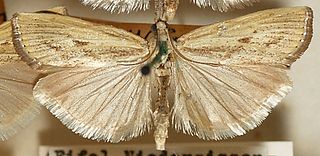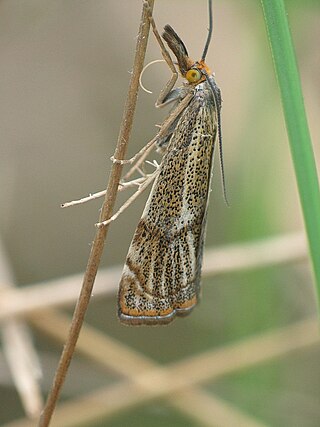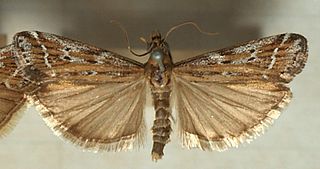
Moths are a paraphyletic group of insects that includes all members of the order Lepidoptera that are not butterflies, with moths making up the vast majority of the order. There are thought to be approximately 160,000 species of moth, many of which have yet to be described. Most species of moth are nocturnal, but there are also crepuscular and diurnal species.

The Noctuidae, commonly known as owlet moths, cutworms or armyworms, are a family of moths. They are considered the most controversial family in the superfamily Noctuoidea because many of the clades are constantly changing, along with the other families of the Noctuoidea. It was considered the largest family in Lepidoptera for a long time, but after regrouping Lymantriinae, Catocalinae and Calpinae within the family Erebidae, the latter holds this title now. Currently, Noctuidae is the second largest family in Noctuoidea, with about 1,089 genera and 11,772 species. This classification is still contingent, as more changes continue to appear between Noctuidae and Erebidae.

Crambinae is a large subfamily of the lepidopteran family Crambidae, the crambid snout moths. It currently includes over 1,800 species worldwide. The larvae are root feeders or stem borers, mostly on grasses. A few species are pests of sod grasses, maize, sugar cane, rice, and other Poaceae. The monophyly of this group is supported by the structure of the tympanal organs and the phallus attached medially to the juxta, as well as genetic analyses.

Agriphila geniculea, the elbow-striped grass-veneer, is a species of moth of the family Crambidae. It was first described by Adrian Hardy Haworth in 1811.

Agriphila inquinatella is a small moth species of the family Crambidae. It is found in Europe, around the Caucasus area to Turkestan, and in the Near East to Jordan. The type locality is in Austria.

Nomophila noctuella, the rush veneer, is a species of moth of the family Crambidae.

Scoparia basistrigalis is a species of moth of the family Crambidae. It was described by Henry Guard Knaggs in 1866 and it is found in Europe.

Anania coronata, the elderberry pearl, elder pearl or crowned phlyctaenia, is a species of moth of the family Crambidae. It was described by Johann Siegfried Hufnagel in 1767 and is found in the northern parts of the Palearctic realm. It was previously also listed for the Nearctic realm. The species closely resembles Anania stachydalis.

Hyles livornica, the striped hawk-moth, is a moth of the family Sphingidae.
Xanthocrambus is a genus of moths of the family Crambidae described by Stanisław Błeszyński in 1957.

Thisanotia is a monotypic moth genus of the family Crambidae described by Jacob Hübner in 1825. Its single species, Thisanotia chrysonuchella, described by Giovanni Antonio Scopoli in his 1763 Entomologia Carniolica, is found in Europe.

Euchoeca is a monotypic moth genus in the family Geometridae erected by Jacob Hübner in 1823. Its only species, Euchoeca nebulata, the dingy shell, was described by Giovanni Antonio Scopoli in 1763. It is found in the Palearctic realm, from Europe across Russia to Japan.

Chrysocrambus craterellus is a species of moth of the family Crambidae. It was first described by Giovanni Antonio Scopoli in his 1763 Entomologia Carniolica.

Pempeliella ornatella is a moth of the family Pyralidae described by Michael Denis and Ignaz Schiffermüller in 1775. It is found in most of Europe, east to the Ural, Siberia, central Yakutia and Kyrghyzstan.

Micropterix schaefferi is a species of moth belonging to the family Micropterigidae that was described by John Heath in 1975. Male Micropterix schaefferi have a wingspan of 3.8–5.1 millimetres (0.15–0.20 in), while females have a wingspan of 4.7–5.8 millimetres (0.19–0.23 in). It is known from France, Corsica, Italy, Belgium, the Netherlands, Germany, Switzerland, Austria, Hungary, Czech Republic, Bulgaria, Denmark, and Poland. Moths in this species inhabit woodlands with many beech and coniferous trees, and are also known to inhabit moist ravine forests and dry pine forests.
Xanthocrambus lucellus is a species of moth in the family Crambidae. It is found in France, Germany, Switzerland, Austria, Italy, Slovakia, Hungary, Romania, Croatia, Bosnia and Herzegovina, Russia, Korea, China and Japan.
Xanthocrambus watsoni is a species of moth in the family Crambidae described by Stanisław Błeszyński in 1960. It is found in North Africa, including Morocco and Algeria.

Aethes hartmanniana, the scabious conch, is a moth of the family Tortricidae. It was described by Carl Alexander Clerck in 1759. It is found in most of Europe, Asia Minor, Armenia and the southern Urals. The species occurs in chalky and limestone habitats.

Eratophyes is a genus of moths in the family Oecophoridae. It contains only one species, Eratophyes amasiella, which is found in Asia Minor, the Netherlands, Germany, Denmark and Sweden. It was first recorded in Belgium in 2004. The species was probably accidentally introduced in western Europe, most likely as a caterpillar or pupa, with logs.
Accra canthararcha is a species of moth of the family Tortricidae. It is found in the Democratic Republic of Congo.
















